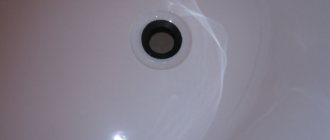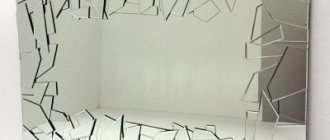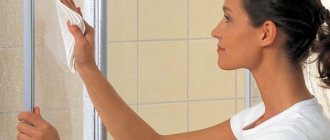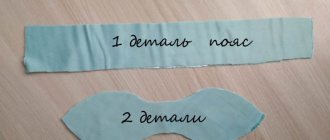It is difficult to achieve perfect cleanliness of curtains in the bathroom, because they are constantly exposed to high humidity and steam, which is fertile ground for the development of fungi and bacteria.
Constant contact with water leaves a limescale deposit on the curtain, which is also difficult to clean.
What you need to know before cleaning
Caring for a curtain in a bathroom depends on what it is made of. The most common materials are:
- Polyvinyl chloride, polyvinyl acetate. Curtains made of polyester and vinyl are the most durable and durable, easy to clean, they must be washed with powder and bleach.
- Fabric with water-repellent impregnation; These curtains are very comfortable and practical. Impregnation allows you to easily and quickly wash away traces of water without leaving any traces. Simply wipe with a clean cloth. These curtains can be washed once a week.
- Polyethylene. The cheapest and most short-lived. It is necessary to change once a month in the absence of proper care. Pemolux, Comet or baking soda are usually used for cleaning. With proper care, they maintain quality for up to 6 months. It is better not to wash the plastic curtain, but to clean it.
- Glass. It is enough to use standard glass cleaning products. Easily tolerates any home remedies.
Before cleaning the curtain, you need to carefully study the label, which usually indicates whether the product can be washed, at what temperature it should be washed, and whether the use of products containing chlorine is allowed.
Reasons for the appearance of various contaminants
First, it’s worth considering what kind of contamination the curtain in your bathroom is susceptible to, and we’ll also find out the reasons for the formation,
so that in the future you can prevent the appearance of unwanted contaminants:
It usually appears at the bottom of the curtain, due to the fact that it comes into contact with foam or soapy water. In order to prevent the appearance of an unsightly yellow tint, after taking a bath or shower, rinse the curtain with clean water and then dry thoroughly.
Yellowness.- White stains (plaque). Due to the fact that there is a lot of magnesium and calcium salts in the water, it becomes hard. This is the reason why white marks appear after the water dries on the curtain.
- Rust. Although it seems strange that rust would appear on a shower curtain rather than on metal, it does happen. Red stains are very difficult to remove, and it is possible to get rid of them if they are not old. Most often, such stains appear on the bottom of the curtain, because it is this fragment that is constantly in contact with water.
- Mold. Very favorable conditions for its appearance and reproduction are an increased level of humidity and heat, which is the environment that exists specifically in the bathroom. Also, most often the fungus can be seen in the folds of the shower curtain. Removing moisture from the surface of the curtain and having a good ventilation system that is constantly functioning will help prevent mold stains from forming on the surface.
Now that we have figured out the reasons for the formation of dirt, it is worth finding out what products can and should be used to wash the curtains.
How to wash curtains
The most effective way to clean bathroom curtains is by washing them. Products made of polyvinyl chloride and polyester are best washed.
It is recommended to wash the curtain in an automatic machine, turning on the “delicate wash” program at a temperature of 40°.
If it is allowed to use bleach, then the available detergent is poured into the detergent compartment, for example, Belizna, Domestos or any other.
If the use of chlorine is prohibited, it is correct to soak the curtain with Vanish or any other non-chlorine product before washing.
If the dirt is heavily soiled, you can turn on the “spot” mode. Under no circumstances should the product be dried or wrung out in a machine.
For the best effect, you need to throw a couple of old towels into the machine with the curtain at the same time: they will play the role of a brush during washing.
The following methods can be used:
- Pour 120 ml of vinegar into the detergent compartment, the same amount of water, 2 tbsp. l. soda, 25 drops of pine oil. Wash the curtain on the gentle cycle.
- Use half a glass of apple cider vinegar and 60 ml of liquid bleach on the “delicate” cycle in cold water. It is advisable to dry it in the sun.
If you need to wash the curtain in an activator-type machine, you should first soak it in warm water with laundry soap or bleach for 2 hours. Then scrub the dirty areas with a brush and wash in warm water.
Experienced housewives advise that instead of powder, in this case, throw a few handfuls of soda into the car, and then rinse the product: first in a vinegar solution (2 tablespoons per 1 liter of water), and then in clean water.
General recommendations for any type of washing:
- After washing, soak the curtain in a salt solution for half an hour, then let the water drain and immediately hang it in place. At the same time, a protective film is created on the surface of the curtain, which will protect it from rapid contamination.
- Do not squeeze.
- Turn on the “delicate wash” mode with a temperature no higher than 40°. Sometimes the label may indicate a maximum allowed temperature of 30°.
- Wash with regular powder, with the addition of bleach.
By the way, before washing it is recommended to remove the rings from the curtains or wash them in a special laundry bag.
Handwash
First, the curtain should be soaked in warm water with bleach. Add stain remover and soda to the washing water. Wipe particularly dirty areas with a brush using the following mixture: a glass of baking soda and half a glass of warm water.
After this, you need to rinse, add 3 packs of citric acid to the rinse water. Then place the curtain in a solution of 5 tablespoons of salt per 1 liter of cold water. After half an hour, remove and hang.
Curtain care
To protect the curtain in the bathroom from mold, mildew and other contaminants, you need to do the following once every two weeks (or once a month):
- Clean it with any bathroom and kitchen cleaner. To do this, the product should be diluted in half with water, poured into a spray bottle, sprayed on the curtain and wiped with a sponge. Then rinse with clean water.
- Dilute 100 g of soda in 0.5 liters of hot water, spray and clean with a sponge.
These methods are good if the curtain is not very dirty. With regular use of these methods, you can protect the curtain from stains and dirt.
Adviсe
Remembering how difficult it was to wash off mold, you should think about how to prevent its reoccurrence. There are several points by following which you can avoid the problem returning:
- If you throw away items affected by flowering fungus, you need to pack them as tightly as possible and minimize the contact of fungal spores on surfaces in other rooms. It doesn’t hurt to pack the product in several garbage bags.
- Eliminate sources of moisture: fix the sills so that the walls are not saturated with rainwater, replace leaking plumbing fixtures, get a dehumidifier if the humidity in the room is caused by factors beyond your control.
- If you have been fighting an infestation for a long time, check for the presence of fungus in places hidden from view: surfaces under the sink, drywall, inside door frames, under the floorboards. It is not difficult to detect them - a characteristic smell, deformation, or a black edging at the joints will help identify the problem.
How to remove mold from a bathroom curtain
Mold occurs due to a fungal infection in the bathroom, which thrives in a humid environment. The fungus does not tolerate high temperatures, so it is advisable to use hot water when cleaning curtains:
- Take half a liter of milk and water, add 1 tbsp. l salt. Soak for 2 hours, then brush, rinse and dry.
- Squeeze the juice of 5 lemons, add hot water. Place the curtain in this solution. After 20 minutes, wash.
In case of very strong dirt and mold, you need to spread a few drops of Domestos with your hands over the curtain (don’t forget to wear gloves!), which must first be moistened. Leave for 15 minutes and wash.
The most durable curtains are vinyl. They can be sprayed with a strong saline solution and wiped with a rag after half an hour. Or soak overnight in warm water with two handfuls of washing powder, and wash in the morning.
Fabric curtains are very beautiful, they are quite easy to care for: they can be washed well in the washing machine. But if it is heavily soiled, you can wash the curtain in the bathroom from mold by first soaking it in Domestos (1 cap per liter of water), then cleaning it with a brush and washing it in the machine.
For very severe stains, when neither vinegar nor ammonia help, you can apply White to the curtain, and after a couple of minutes wash it in the machine. The spots disappear completely.
Warnings
If the pest returns again and again, you should think about replacing the coating. When, after numerous cleanings, stains appear with renewed vigor, try opening the tiles, floors or wallpaper in a small area and check whether mold has damaged them at the root. If this happens, it would be advisable to replace the damaged area. Otherwise, the hidden problem will continue to cause both aesthetic damage to the interior and harm to your health, since spores remain in the air of this room.
How to wash curtains from yellowness and rust
Add a little bleach and a little stain remover to warm water and soak the product for several hours. If the curtain material is delicate, then soak it in Vanish solution. Stronger materials that are heavily soiled can be cleaned with White.
Very delicate curtains are cleaned of yellowness as follows:
- mix 1 part peroxide and 3 parts ammonia;
- moisten a sponge or brush in this solution and wipe the curtain;
- Rinse with clean, cool water and add a drop of fabric softener to neutralize the ammonia smell.
Be sure to wear gloves. If the curtain is heavily soiled, soak it in a solution of citric acid and soda before washing. It is recommended to treat the curtain in this way to prevent yellowing.
Is it possible to put it in the washing machine?
Washing curtains in a washing machine is the easiest way to freshen the material.
If curtains are used regularly, such treatment should be carried out once every 60-90 days. Procedure:
- Remove the curtain.
- If it has removable fasteners or removable decor, they must be removed.
- Place the product in the drum.
- Select the “Delicate” mode.
- Make sure that the temperature is no more than 40°C.
- Disable the “Drying” and “Spin” modes.
- Start the machine.
- Remove the wet curtain from the drum and hang it in place, allowing the water to drain into the bathroom.
Adding two terry towels to the load with a curtain will help enhance the effect of washing. Their rough surface will help clean the curtain better.
This treatment is suitable for curtains that are not heavily soiled. Otherwise, it is advisable to start washing by pre-soaking and treating stains.
The detergent for this procedure should be selected following the recommendations of the curtain manufacturer. If they do not specify strict restrictions, then it is possible to use bleach or other products with chlorine.
With strict restrictions, oxygen-containing bleach without chlorine will help. For example, Vanish. Soaking should be carried out in accordance with the instructions for the specific detergent, and do not use hot water.
How to clean limescale on a bathroom curtain
It is advisable to wipe the curtain with a dry cloth after each shower. But since this is unrealistic in practice, the curtain is constantly covered with limescale due to contact with hard water.
To remove such plaque, the usual means are used:
- Lemon acid. It is added to washing water or soaked with it overnight, and then brushed.
- Vinegar. Wipe off plaque with a brush with the following solution: 2 tbsp. l. vinegar per 1 liter of water.
- Vanish or ACE. Add to washing water.
Do not use detergents to remove limescale from plumbing fixtures to clean curtains. This is only allowed in relation to glass curtains.
Stores sell high-quality products against mold, rust and yellowing: for example, Sanita. Instructions for use are given on the packaging. In addition, Antipyatin, a special laundry soap, is used to remove any stains.
Method 4. Services of specialists
If the problem is not just damp plumbing or a secluded corner in the hallway, but the dark spots have spread to an area of more than one square meter, you will no longer be able to deal with it on your own. The depth and extensiveness of the lesion is an indicator for contacting a professional service. Cleaning companies use special solutions to combat the parasite, as well as devices for deep dry cleaning. Exposure to steam or water with pressurized preparations can even affect stubborn blooms and remove darkening from such difficult areas as furniture, carpets and walls.
Varieties
The modern market offers a decent range of curtains. Models differ in material, color, mounting methods, etc.
By the way, the type of fastening is a very important point for choosing the right curtain. This can be a regular rod (the most common option), eyelets, magnets, chains and others.
For long-term operation of this accessory, it is important to choose the right material from which the curtain will be made and the type of its fastening. The choice of material is also very important both for the operation of the accessory and for its care.
Available today:
The choice of material is also very important both for the operation of the accessory and for its care. Available today:
Are there any restrictions for washing curtains?
Improper washing of bathroom curtains can lead to damage and loss of presentable appearance.
The cleaning method directly depends on the material the curtain is made of.
The most common include:
- polyvinyl chloride;
- polyester;
- polyethylene.
PVC and polyester
Vinyl and polyester for the most part can survive washing and maintain their appearance and performance. Restrictions on cleaning may be given by the manufacturer of a particular product, so you should read the label on the product before washing.
The manufacturer may prohibit machine washing, as well as the use of bleaches. In this case, it is better not to experiment and treat the curtains with your hands with an approved detergent.
If there are no strict restrictions, then automatic washing in a washing machine will be the best option. The exception is the need to remove stains characteristic of the bathroom: from rust, mold or limescale. Household chemicals and homemade recipes are used for these purposes.
Polyethylene
Among all the types of materials that are traditionally used to organize curtains in the bathroom, polyethylene is the cheapest and most fragile.
It is capable of good protection against splashing, but has a very short service life - up to six months.
Such material will not survive thorough washing. Maximum cleaning is a careful treatment with a non-aggressive agent. For example, Pemolux.
Cleaning is carried out with a soft sponge, without using brushes, which can damage the thin material. In case of serious contamination, the plastic curtain is simply replaced with a new one.
Removing stains
There are several very effective ways to combat plaque and rust. For example, you can use a mixture of ammonia and hydrogen peroxide in a ratio of 3 to 1. Apply the product to the stains and rub them with a washcloth, then wash the curtain by hand or in the machine.
It is also not prohibited to use household chemicals Adrilan or Sanita. These compositions are used according to the following scheme:
- Apply a small amount of solution to the stain.
- Hold for a few minutes.
- Rinse with running water and wipe the stain with a dry sponge.
Partial washout
If, in general, the curtain is quite clean, and only the bottom of the product is contaminated, you can not wash the curtain completely, but clean only the contaminated area:
- A solution of vinegar or lemon juice will help to clean the curtain from yellow or white limescale deposits. Apply the composition to
- Acidic compounds work well against traces of rust. As in the previous case, the solution must be applied to the surface of the curtain and not washed off for 5-7 minutes. The acid will dissolve the rust and it can be easily removed with a damp sponge. In addition to vinegar and lemon juice, you can use citric acid. You can sprinkle it on the edge of the curtain or dilute the crystals with water and treat the rusty areas with the resulting solution.
- sponge and wipe the dirty area of the curtain. Leave on without rinsing for a few minutes. Then wipe the curtain again with a sponge and rinse with warm water from the shower.











